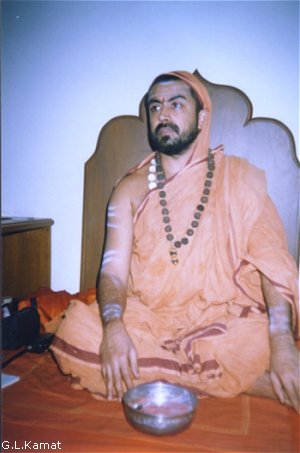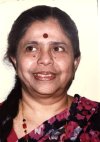| Tuesday, August 15, 2006 | | |
Chitrapur Saraswat Community Musings on a minuscule minority community of Chitrapur SaraswatsThe Saraswats in South India are divided into six groups. Chitrapur Saraswats form one of them. I was born a Chitrapur Saraswat. I married a Goud Saraswat and very soon my husband and myself had to move away from our home-state. My husband, Krishnananda Kamat was a distinguished Kannada writer, with a Ph.D. from New-York state University. I was in All India Radio service which made me, a thana Konkani, develop a pan-Indian outlook, getting exposed to several languages and cultures very different from mine. In addition, members of both my father's family and Kamat's family are among the enlightened ones, who do not stress on caste or cluster barriers. Claustrophobia, from which majority of Indians suffer because of caste restrictions, was only a dictionary word to us. G.L.Kamat While I am an Indian first and foremost, I am at times proud of my Chitrapur (also known as Bhanap) heritage. The Bhanaps are, in the Indian context, a highly advanced community with 100% literacy; it is also a community in which there is no gender-discrimination, and which has first co-operative efforts to its credit like co-operative housing societies, banks, old people's homes etc. Compared to other groups among Saraswats, Bhanaps are more organised, more united and forward looking. They had caste-census more than a hundred years back; first English school more than hundred and fifty years ago and a community magazine which is ninety-six year old. But the community is fast diminishing with very low birthrate and inter-caste marriages. As is common in patriarchal society, wife/children acquire the community identity of the husband/father. To have a clearer idea of the present status and forthcoming danger to this minuscule minority community facts are given in nutshell.
| ||
| Amma's Column by Jyotsna Kamat | ||
Browse Amma's Column by Tags
1920s - ancient India - avatars - banana - bangalore - buddha - calcutta - christmas - coins - colin mackenzie - colonel - conference ii - conversions - cousin - cows - customs - dalit - democracy - dhols - dr narayan - drums - dung - fables - far east - gandhi - gandhiji - great deluge - guru - hinduism - home library - human body - idolatry - kalpa - karnataka - kautilya - kingdoms - krishna - manners - marriage - new books - new year - nuances - obituary - old temple - patience - personalities - peru - pontiff - postal service - prime source - queen - rao - relevance - religion - revolt - romance - runners - saga - saints - Saints of India - salt satyagraha - science - shaven heads - sher - sri lanka - suresh - terracotta - tradition - trauma - tsunami - tulunadu - unity - universality - women - zen - 11th century - 75th anniversary - alberuni - all india radio - amrita - ancient art - ancient india - ancient indians - animals - anmori - arthashastra - autobiographical notes - b_g_l_swamy - babies - basham - bedas - belief - bengaluru - bhagat singh - Bhagatsingh as seen by Kamaladevi. - bhagavata purana - bhagirath - Bhakti Cult - bharata - bhat - blouse - brahmin - brute - buddha jayanti - card games - cart - caste system - centenary tribute - centennial - chanakya - chariot - cheers - chilli - chinese monk - Christmas - christmas eve - cloud messenger - cockfights - code of manu - colonel colin - complete works - conch shell - cuisine - curry - customs - dasa - demons - dessert - devil worship - dhyan - dikshit - dikshitar - discovery - doldrums - eknath - elephant - empire - epigraphy - fanny - festival foods - festive - forest scene - freedom - gandhi - gandhiji - ganesh - gautama buddha - gayatri mantra - gesture - Goa - gods - gramophone record - grandmother - great men - grinder - guru - happy new year - haste - helping hands - hind swaraj - hind_swaraj - hindu - hindu religious symbols - hindu texts - hinduism - hindus - history conference - humanist - hunger - idolatry - indian civil service - indian names - indians - institution of marriage - interviews - jaina - juggernaut - kamath - kannada - karnataka - kasaragod - kavya - keladi - krishna - laughing buddha - legacy - lotus - loving touch - m n srinivas - mallya - mama - mango season - manu - masters - materialism - medieval india - memories - middle path - midwife - misadventure - moorthy - music tradition - musical - musings - narad - narada - new articles - night life - obituary - offerings - old photo - Om - ornaments - pai - pampa - panchatantra - peacock - peacock dance - peacock dress - pearls - philanthropist - pigeons - poet - poetess - potpourri - prayer - prehistory - promising artist - prostitutes - queen - quilt - rahul - rajasthan - rajendra - ramayana - ramdas - rao - rare volume - robber - roots - rubaiyat of omar khayyam - saints - sane guruji - saraswati - saraswats - science - scorn - sea navigation - sedam - serpent worship - shameful practice - sharana - shastra - shivaji - silver art - sorab - south east asia - south india - subba rao - sunset - swami - swamy - swastika - tara - tea - temple school - temple town - terracotta_town - three books - tiger - titan - tonsure - torave_ramayan - tradition - translator - travelogue - tree of life - tribute - tsunami damage - Tulasidas - tuluva - upanishad - vedanta - vedas - viswanath - Viswanath Kashinath Rajwade - vivekananda - w h sleeman - wall paintings - what is in a name - wilks -
Jyotsna Kamat Ph.D. lives in Bangalore.
More articles by Jyotsna Kamat

